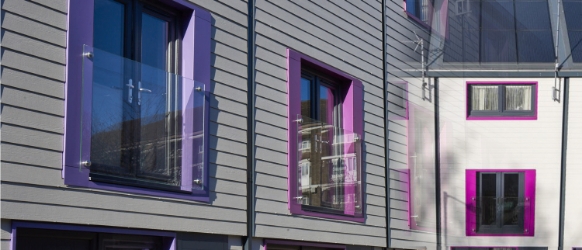As the world continues to grapple with the impacts of climate change, there has been an increase in awareness about the need to reduce carbon emissions and transition to more sustainable practices. A major shift has been taking place in the UK’s construction industry in particular, as the nation’s residential and commercial buildings account for 25% of our total greenhouse gas emissions 1.
From zero-carbon buildings to the use of recycled and natural materials, there are a range of approaches that have been taken to make construction more environmentally friendly and socially responsible. Below are three innovative examples of sustainable construction in the UK, and although it would not be feasible to implement their practices in every project, they provide insight and inspiration into the future of construction and exemplify how we can build a greener, more resilient future for everyone.
Brighton Waste House, Brighton
Like its name suggests, the Brighton Waste House 2 claims to be the UK’s first permanent house constructed from rubbish and was built in 2014 with the aim of proving that houses can be built quickly and inexpensively using waste and surplus material. Led by architect and university lecturer Duncan Baker-Brown, this unique project was constructed in collaboration with other architects, engineers and students on the University of Brighton’s campus.
Over 85% waste and recycled materials were used to construct this building, including some very unusual items, such as 19,800 toothbrushes and 4,000 DVD cases 3, which were repurposed as insulation for the walls. Recycled construction materials were used in this project as well, including timber offcuts, old clay tiles and wooden pallets. In keeping with its sustainable design, many elements of the house can be disassembled and reused once it reaches the end of its life.
While it is unlikely that every building in the future will be constructed from rubbish, Brighton Waste House demonstrates that it is possible to create a building using sustainable or discarded materials to reduce the environmental impact of construction.
Hope Rise, Bristol
Hope Rise is an innovative development of modular starter homes 4 aimed at providing inexpensive, sustainable social housing for young people at risk of homelessness. Constructed to sit on stilts over a working car park in Bristol, this inspiring project was led by Zero Carbon Developments (ZED), in collaboration with the local community and Bristol City Council. The design focuses on environmental sustainability, utilising low-carbon materials for construction and renewable energy for utilities, such as solar panels and rainwater harvesting. Many of the building components were prefabricated in a factory before being installed on-site in just five days.
This project is a great example of how sustainable and affordable homes can be built to meet the requirements of local communities, particularly for high-poverty areas in need of improved social housing. While it has helped to reduce carbon emissions and promote sustainable living, Hope Rise is also a case study for sustainable development and community engagement which can be replicated in other parts of the UK.
NCH2050 Homes, Nottingham
Sustainable construction and design are not just limited to new builds, however. NCH2050 Homes, an exemplary net zero energy project in Nottingham 5, has proved this through their scheme to tackle fuel poverty, climate change and energy efficiency by retrofitting existing homes to make them more sustainable and reduce heating and energy bills for the homeowners.
The houses are upgraded by installing prefabricated super-insulated wall panels and roofs, new doors and windows, solar panels, an energy-efficient heating and hot water system and more. The end result is a building which can self-generate the total amount of energy that is required for heating, hot water and electrical appliances.
Increasing the energy-efficiency of homes across the UK is a crucial step forward in both the climate and cost-of-living crises, and with more support from local councils and the government, projects like the NCH2050 Homes could extend across the country in the next 10 years.
References
1. committees.parliament.uk/emissions-must-be-reduced
2. brighton.ac.uk/brighton-waste-house
3. idealhome.co.uk/news-waste-house
4. zedpods.com/hope-rise-zero-carbon-affordable-homes-from-zed-pods
5. housing.org.uk/nottingham-city-homes

Building A Greener Future: Sustainable Construction in the UK

First published on 700115